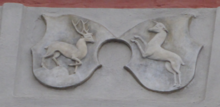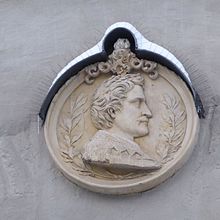Golden Cross (Regensburg)
The Golden Cross is a former patrician castle or a family tower on Haidplatz in the Upper Palatinate capital of Regensburg in Bavaria (Haidplatz 7).
history
Building history
The tower of the house in the east and the four-story house adjoining the tower to the west were built in the early Middle Ages around 1250. The Weltenburgers are named as the oldest owners of the ensemble . As a coat of arms from 1456 makes clear, the councilor Hermann Zeller acquired the house from the widow Anna Weltenburger. This owner was followed by a series of important Regensburg patrician families , such as the Krafft , the Seidl , the Schwöller , the Schlumberger and the Hauer . The adjoining western, originally three-storey building with a steep gable roof and bay window - built in 1521/27 - was owned by Hans Thuner and his wife Ursula, née Fugger , according to a bronze inscription from 1527 on the bay window . The alliance coat of arms of the two (with stag and roe deer) returned again on the window parapet of the second oriel floor. Only in 1862 was this younger building with the bay window added two storeys. After that, today's uniform facade was created by adding a continuous crown of battlements . This gave the entire property the impressive effect of a patrician castle. The interior of the rooms was designed according to the latest fashions, especially in the parts facing Haidplatz . The baroque stucco ceiling has been preserved in the Imperial Hall and the Art Nouveau ceiling of the dance hall in the rear building, which has been famous for its dance floor swinging on springs since it was set up in 1865.
History of use
The building was used as an inn as early as the 16th century, with emperors and kings, princes and diplomats staying in the comfortable inn. Around 1530, Emperor Ferdinand I took up residence here on his coronation trip to Aachen . Emperor Karl V stayed in the Golden Cross three times, including during the imperial assemblies between 1532 and 1541. During his last stay, the widowed emperor met his old love Barbara Blomberg , daughter of Regensburg's belt maker Wolfgang Plumberger and his wife Sibilla, and fathered with her the illegitimate son Don Juan de Austria . An inscription on the tower of the Golden Cross reports on this event, which was then top secret.
. After the occupation of Regensburg during the Thirty Years' War by the Swedes in November 1633, its commander-in-chief Bernhard von Sachsen-Weimar took quarters for a while in the Gasthof zum Goldenen Kreuz.
Until 1898 many celebrities resided in the luxury hotel. In 1863 Emperor Franz Joseph of Austria was a guest. Due to the great interest shown by the emperor in Don Juan de Austria, the hotel owners at the time, Karl and Adolf Peters, had a picture of the hero of Lepanto affixed to the front of the house in 1865 , which was made by the Stadtamhofer sculptor Friedrich Preckel (a commemorative coin from 1571 served as a model ). The text comes from the local historian Carl Woldemar Neumann and reads:
"In this old-fashioned house / has often guessed after a long journey to Mr. KAYSER CARL THE FIVE / well known all over the world / he also had a good hour kissed a young kfraw.
The same was called for far and near. One was only the beautiful BARBARA / Her tribe was upright / plain and right PLUMBERGER wrote the sex / the Kayser dearly brought a lot of suffering / but consolation and heyl of Christianity.
Then from it grew / like the father DON JUAN VON OESTERREICH / who was LEPANTO in the battle / the Türckhen has destroyed power. the LORD retaliates against him at all times / as well as in eternity. "
Even King Ludwig I of Bavaria stayed both in his time as Crown Prince, as well as King in the Golden Cross. He was a guest here in 1842 on the occasion of the opening ceremony of the Walhalla . On the occasion of the inclusion of a marble bust in the Walhalla of King Ludwig I on August 25, 1890, Prince Regent Luitpold unveiled a stucco tondo on the Golden Cross with a relief bust of King Ludwig, which had been donated by the hotel owner Wilhelm Schrotberger at the time.
For the Ministerial Conference of 1865, the Golden Cross served as the venue. At that time u met here. a. King Wilhelm I of Prussia , the then Prime Minister of Prussia Otto von Bismarck , King Johann of Saxony and his wife Amalie Auguste of Bavaria . King Ludwig II of Bavaria stayed for a few hours in the Golden Cross on August 10, 1871, when he drove to meet Kaiser Wilhelm I in Schwandorf that day . Kaiser Wilhelm I stayed in the Golden Cross.
A special feature in the building was a "swinging dance floor" that the owner Peters had built in 1865. In the late 19th century, the so-called "cross balls" celebrated here were important social events.
The decline of the hotel "Zum golden Kreuz" began after 1810 with the emergence and development of the new Maximilianstrasse, which was then planned as a boulevard . With this street, the city oriented itself towards the train station and at the end of this street at that time, the Parkhotel Maximilian was built in 1888 near the train station and surrounded by the trees of the Fürst-Anselm-Allee as a new splendid hotel . In 1898 the famous “Zum golden Kreuz” inn closed its doors.
Details of the construction
Until 1862 the building consisted of an early Gothic tower, a western residential extension and a further low extension with a stepped gable . As a result of the reconstruction that was then carried out, the earlier parts of the building were given a uniform front with battlements. The bay window was built up to the fourth floor.
The seven-story tower of the Golden Cross ends with a crenellated wreath . In the 3rd and 4th floor a pointed arch double are sorted arcade , separation column and chalice capitals are from 1250. On the east side there are two loopholes . In the adjoining residential building, a three-arched arcade has been preserved. One dedicated to St. The chapel consecrated to Leonhard was probably located on the ground floor of the tower. A room later used as a chapel was subdivided in 1898 and exposed again during renovations in 1933. It has four cross yokes that are supported by an eight-sided central pillar. The vault dates from the 15th century; Emperor Charles V washed the feet of twelve old men here at Easter 1541 . It was not until 2013 that a black wooden board for 30 room keys was found on the door to the former house chapel, which was obviously converted into a reception after the Reformation.
The so-called “Kaisersaal” is located on the first floor of the residential wing. The baroque stucco ceiling dates from 1650, the imperial eagle can be seen in the middle field, the four elements are shown in the corner fields . In the rear building, also on the first floor, there is the so-called “Kreuzsaal”, in which the famous “Kreuzballs” took place. This is equipped with Art Nouveau painting.
Development of today's usage
After the hotel was closed in 1900, guests were not welcomed again in a café until 1968. When the house was sold to the Horsch family in 1977, the building was in a dilapidated overall condition. The desolate statics of the building were a major challenge for the planners and preservationists. In addition to buried wells, broken beam ceilings, rot and worm infestation were discovered. All the ceilings had to be secured and relieved of debris. The entire foundation of the house was revised to restore stability. Stairs and roof structures were renovated or renewed. The interior and exterior plaster, including the wall paintings, had to be restored. New doors and windows were installed and heating and water supplies were installed. Overall, a gigantic task was mastered and modern apartments and business premises were created. The “Hotel Goldenes Kreuz” of the Horsch family has been in operation in the building since 2005. The “Café Goldenes Kreuz” is located on the ground floor, presumably in the hall that was once the meeting place for kings. In addition to various shops (e.g. the violin maker Helmut Pöser or "Bang & Olufsen"), the "Keup Action House" is also located here.
literature
- Karl Bauer : Regensburg. Art, culture and everyday history (6th expanded and improved edition, pp. 303–307). Mittelbayerische Druck- und Verlags-Gesellschaft, Regensburg 1997, ISBN 978-3-86646-300-4 .
Individual evidence
- ↑ a b Katja Lemper: The Golden Cross –Patrizierburg on Haidplatz and hotel of the high aristocracy. In: 40 years of urban development funding in Regensburg - a success story . City of Regensburg, Planning and Building Department, Office for Urban Development, Regensburg 2011, ISBN 978-3-935052-96-2 , p. 57 f .
- ↑ New discovery in the Kaiserherberge
- ↑ Homepage Hotel Goldenes Kreuz
- ↑ Homepage violin maker Pöser
- ^ Homepage of the Keup auction house
Web links
Coordinates: 49 ° 1 '11.7 " N , 12 ° 5' 33.8" E





